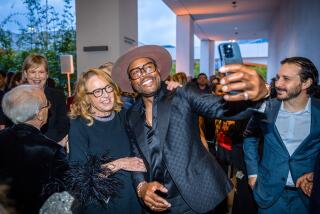Bittersweet Time for Museum Head
- Share via
WASHINGTON — There were more than 700 on hand at the National Gallery of Arts Wednesday night to welcome Earl A. (Rusty) Powell III to his new job as director of the gallery, and to bid farewell to his predecessor, J. Carter Brown.
A chipper Powell, eyes beaming, was clearly enjoying the first major National Gallery event held under his watch. He was sad to leave Los Angeles--where he was director of the Los Angeles County Museum of Art for 12 years--but was excited to come back to Washington, where he once worked as a mid-level administrator at the National Gallery, to assume one of the most prestigious museum jobs in the country.
“It’s a very bittersweet move. I love L.A., and I love the people,” said Powell’s wife, Nancy.
From artists Nancy Graves, James Wyeth and Kenneth Noland to chief executives such as World Bank President Lewis Preston, to Supreme Court justices, U.S. Congressmen and ambassadors, the list of honorable guests who attended was impressive.
In a heavily D.C.-New York crowd were a few Californians, including L.A. businessman Julian Ganz Jr., artist June Wayne, Franklin D. Murphy, chairman of the board of the National Gallery and a director emeritus of Times Mirror, and Times Mirror CEO Robert F. Erburu.
After standing politely in a receiving line for two hours, and then noticing their guests had finally occupied themselves with the reception’s culinary offerings of Norwegian gravadlax, gougere and canard a la Bigarade, Powell and Brown managed to slip away and share some thoughts.
They left the sea of government, business and entertainment celebrities behind on the main floor of the East Building, proceeded up the stairs to the mezzanine, and then up a final flight of stairs to another landing. Looking over the mass of suits and dresses, they talked of the past and the future.
“I first spotted (Powell) in Austin, Tex.,” Brown said of his successor, who was appointed Sept. 8. “It occurred to me that he had rare potential, someone who had a passion for art, but yet had his feet on the ground. He was a people person, yet he could also handle the administrative details. . . . When he went to Los Angeles, he burned up the track. He moved that institution (the Los Angeles County Museum of Art) into glory,” Brown added.
“These are intense jobs,” Powell said, explaining how he had lacked time to enjoy the climate in L.A. Before Powell left Los Angeles, he complained that the air conditioning in his office was always a little too cold.
Perhaps that problem will follow him to Washington if one goes by the history of the giant Calder mobiles that now hang from the gallery ceiling, circling slowly above the guests’ heads. The aluminum contraption had initially failed to turn as had been intended by its creator, the late Alexander Calder. The curators then tried turning up the air pressure on it, but this also failed to budge the work. They then turned up the air conditioners full blast.
“We thought we had a dud,” explained Jeremy Strick, associate curator of the gallery. “But then we loosened a bolt on top of the ceiling and it spun around like crazy.”
Speaking more seriously, Strick said he has been impressed in his meetings so far by Powell and, like others, spoke positively of the future of the National Gallery.
“There are going to be a lot of changes,” predicted Phyllis Wyeth, the wife of artist James Wyeth.
More to Read
The biggest entertainment stories
Get our big stories about Hollywood, film, television, music, arts, culture and more right in your inbox as soon as they publish.
You may occasionally receive promotional content from the Los Angeles Times.










